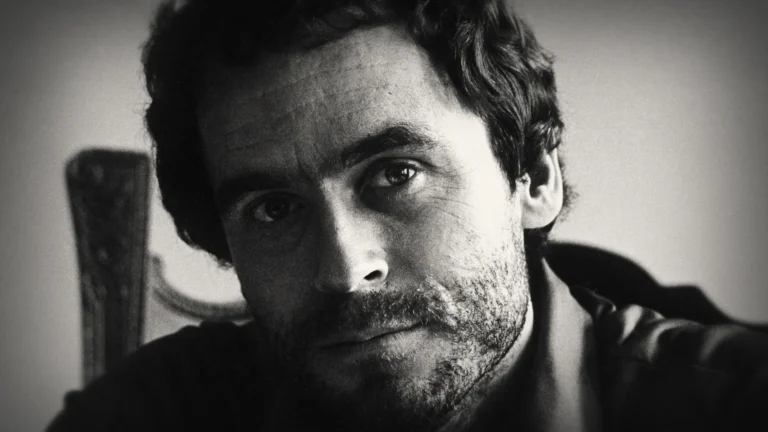Few names evoke the chilling intrigue and morbid fascination as that of Ted Bundy. Known as one of the most infamous serial killers in American history, Bundy’s heinous crimes shocked the nation and left a trail of devastation in their wake. Despite the passage of decades, the enigma surrounding Bundy and the gruesome details of his murders continue to captivate the public imagination. In this article, we will delve into the life, crimes, and legacy of Ted Bundy, exploring the factors that shaped his descent into darkness and the lasting impact of his reign of terror.
Early Life and Background:
The story of Ted Bundy begins on November 24, 1946, in Burlington, Vermont, where he was born Theodore Robert Cowell to Eleanor Louise Cowell. Raised in a middle-class family, Bundy’s early years were marked by instability and uncertainty surrounding his paternity. He was led to believe that his grandparents were his parents and that his mother was his sister, a deception that would later contribute to feelings of abandonment and identity confusion.
Bundy’s childhood was relatively unremarkable, though there were signs of troubling behavior early on. He exhibited a fascination with knives and violence, and his social skills were described as awkward and strained. Despite these warning signs, Bundy was able to maintain a facade of normalcy, excelling academically and earning a scholarship to attend college.
Modus Operandi and Killing Spree:
Ted Bundy’s reign of terror began in the early 1970s when he embarked on a cross-country killing spree that would claim the lives of at least 30 young women. Bundy’s modus operandi typically involved approaching his victims under the guise of needing assistance or pretending to be injured, before overpowering and assaulting them. He would then brutally murder his victims, often using blunt objects or strangulation, before disposing of their bodies in remote locations.
What made Bundy particularly terrifying was his ability to blend in seamlessly with society. Handsome, charismatic, and articulate, he was able to gain the trust of his victims and evade suspicion from law enforcement for years. His chameleon-like ability to adapt his appearance and behavior allowed him to evade capture and continue his killing spree unchecked.
Arrest, Trials, and Escapes:
Ted Bundy’s reign of terror came to an end in 1975 when he was finally apprehended by authorities in Utah after a routine traffic stop. Evidence linking him to multiple murders began to emerge, and Bundy was subsequently charged with numerous counts of murder and kidnapping. During his trials, Bundy attempted to represent himself in court and often charmed and manipulated jurors with his charisma and intelligence.
Despite overwhelming evidence against him, Bundy managed to escape from custody twice during his legal proceedings. The first escape occurred in 1977 when he jumped out of a courthouse window in Colorado and went on the run for several days before being recaptured. The second escape took place in 1978 when he sawed through the ceiling of his jail cell in Florida and remained at large for over a month before being apprehended again.
Legacy and Cultural Impact:
The legacy of Ted Bundy extends far beyond his gruesome crimes. His case has become synonymous with the concept of the “charming psychopath” and has been the subject of numerous books, documentaries, and films. Bundy’s ability to manipulate and deceive those around him has fascinated psychologists and criminologists for decades, leading to extensive research into the psychology of serial killers and the nature of evil.
Bundy’s case also sparked a national conversation about the failings of the criminal justice system and the importance of victim advocacy and support. His victims, many of whom were young women, are remembered and honored through various memorials and initiatives aimed at raising awareness of violence against women and promoting safety and empowerment.
Final Days and Execution:
In 1989, after years of legal proceedings and appeals, Ted Bundy was finally sentenced to death for his crimes. He spent the final years of his life on death row in Florida’s Raiford Prison, where he granted interviews and made several confessions to additional murders in a bid to delay his execution. Despite his efforts, Bundy was ultimately executed in the electric chair on January 24, 1989, bringing an end to one of the most notorious criminal careers in American history.
Conclusion:
In conclusion, Ted Bundy’s life and crimes serve as a chilling reminder of the capacity for evil that exists within the human psyche. His ability to charm, manipulate, and deceive those around him allowed him to evade capture and continue his killing spree for years, leaving a legacy of fear and devastation in his wake. Though Bundy’s reign of terror may have ended with his execution, his case continues to fascinate and horrify the public, sparking ongoing discussions about the nature of evil, the failings of the criminal justice system, and the importance of vigilance and awareness in preventing future tragedies. As we reflect on the legacy of Ted Bundy, we are reminded of the need to remain vigilant and steadfast in our pursuit of justice and compassion for the victims of violent crime.
Read Also: Exploring the Rise of Kourtney Kardashian: A Cultural Icon Redefining Celebrity

